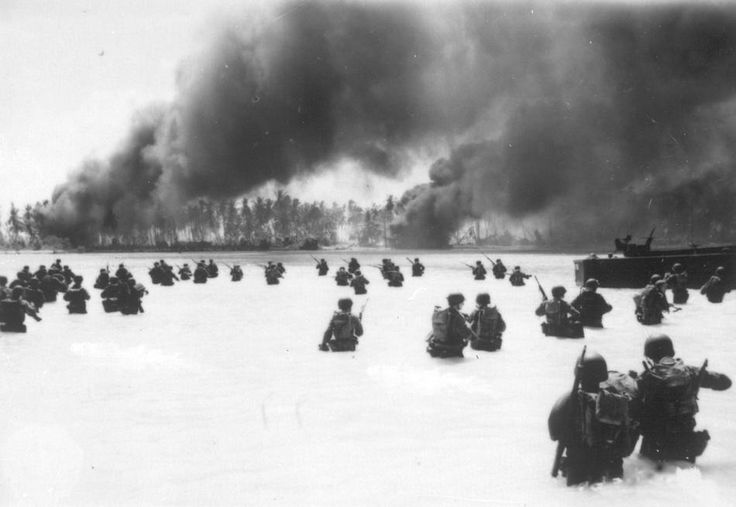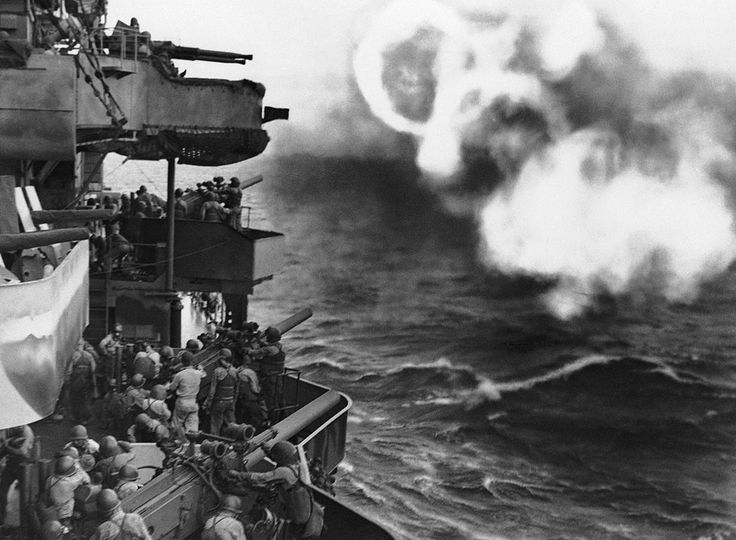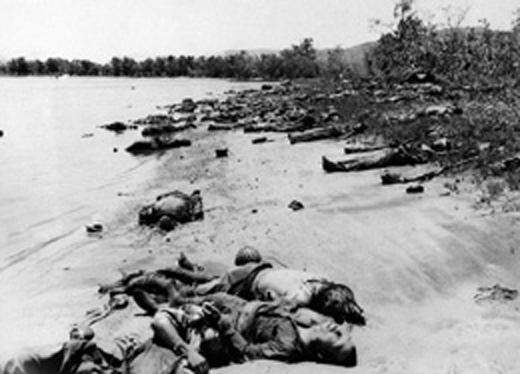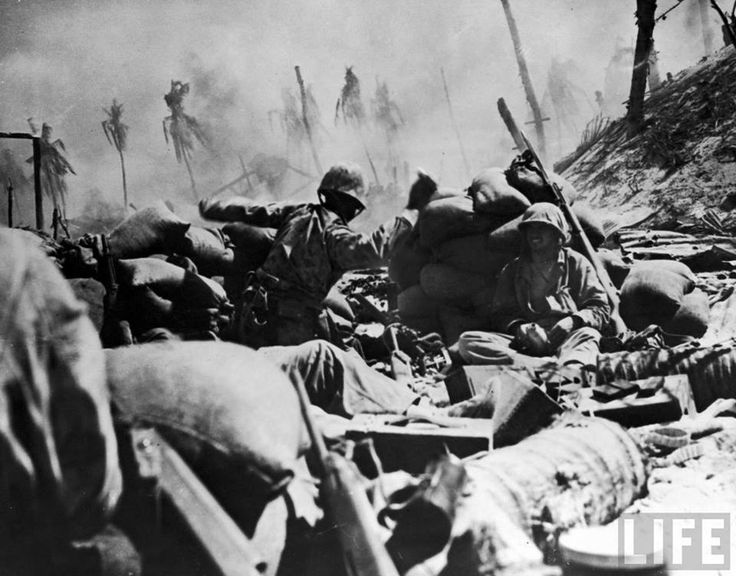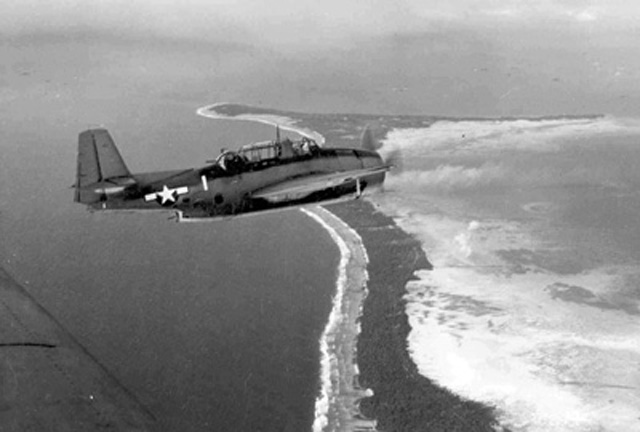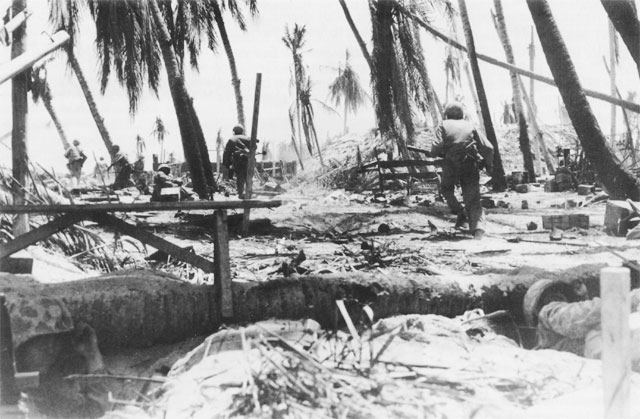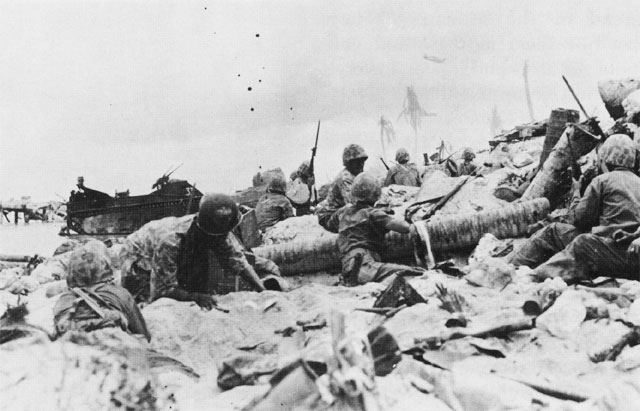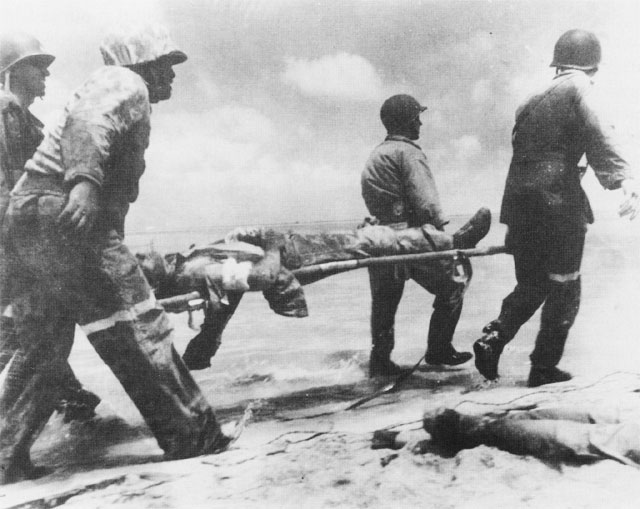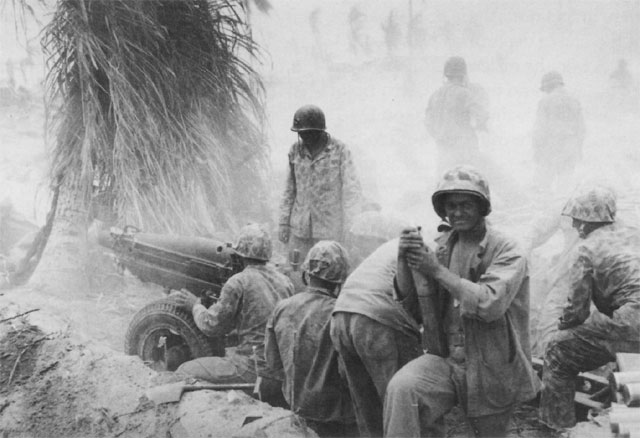Aegean
The British evacuate Samos. The Germans move in on the 23rd and disarm 2,500 troops on the island. This is the end of the brief campaigns in the Dodecanese which has been too quickly improvised by the British with insufficient forces and as a result the British have taken a beating.
[Air Operations, Bismarcks
- 50 V Bomber Command B-24s attack Gasmata.
- During the night, VP-101 Black Cat PBYs sink a cargo ship in Rabaul harbor.
Air Operations, CBI
CHINA- Despite bad weather that grounds other missions, 2 11th Medium Bomb Squadron B-25s are able to attack barracks and warehouses on Nampang Island.
Air Operations, Europe
USAAFITALY:
- Bad weather grounds most 12th and 15th Air Force aircraft, but some NATAF aircraft are able to attack a rail junction and several towns in the German Army zone.
Air Operations, Gilberts
- US forces launch Operation GALVANIC, the invasion of the Gilbert Islands. Following intense air and naval-surface bombardments, the US 2nd Marine Division lands at Betio Island in the Tarawa Atoll, and elements of the US 27th Infantry Division land at Butaritari Island in the Makin Atoll.
- At 0611 hours, US carrier aircraft from Task Group 50.2 (the Northern Carrier Force) mount a 20-minute attack against beach defenses at Butaritari and thereafter stand by to cover the US surface bombardment force and provide ground support as needed. As US Army ground troops begin landing at 0832 hours, carrier aircraft bomb preselected inland targets.
- At 0615 hours, US carrier aircraft from Task Group 50.3 (the Southern Carrier Group) mount a firece 7-minute attack against shore defenses on Betio and thereafter stand by to cover the US surface bombardment force and provide ground support as needed. Owing to delays in landing the first waves, the carrier aircraft attack shore defenses again at 0855 hours. Thereafter, F6Fs provide continuous on-call support for the Marine Corps ground forces.
- A VF-16 F6F downs 1 G4M 'Betty' bomber at sea at 0930 hours.
- Beginning at about 1755 hours, 16 Marshalls-based G4M 'Betty' night torpedo bombers attack Task Group 50.3 while US Navy aircraft are landing. VF-18 F6Fs down 5 'Betty' and ships’ gunners down 4, but 1 'Betty' scores a single torpedo hit on the USS Independence (Light Carrier Air Group 22), which is forced to retire to Funafuti, the nearest friendly base.
- During the night, a Marine Corps reconnaissance company lands at Abemama Atoll from a US submarine and swiftly occupies the atoll against negligible opposition. Abemama is a planned site of a new airfield.
Air Operations, Marshalls
Task Group 50.1 carrier aircraft attack the Mille Atoll.
[Air Operations, New Guinea
50 V Bomber Command B-25s and B-26s attack Japanese Army ground positions around Sattelberg and luggers in Hansa Bay. 3rd Light Bomb Group A-20s attack targets around Lae.
[Air Operations, Solomons
- 13th Air Force B-25s, and P-38s, and US Navy PVs attack the Bonis airfield on Bougainville, and several B-25s attack coastal targets around Empress Augusta Bay.
- A VMF-222 F4U downs 1 Ki-49 'Helen' bomber near Bougainville at 0830 hours.
Baltic Sea
U-768 is sunk in a collision with U-745, the exact circumstances of which are unknown.
| Class | Type VIIC |
| CO | Oberleutnant zur See Johann Buttjer |
| Location | Baltic Sea |
| Cause | Collision |
| Casualties | 49 |
| Survivors | None |
Battle of the Atlantic
U-536 is sunk following a series of attacks by ships of a Canadian Navy Support Group EG5 shadowing combined Convoys SL-139/MKS-30. The ships involved are the Nene, Snowberry and Calgary.
| Class | Type IXC/40 |
| CO | Kapitänleutnant Rolf Schauenburg |
| Location | Atlantic, NE of the Azores |
| Cause | Depth charge |
| Casualties | 38 |
| Survivors | 17 |
Bougainville
The Japanese counterattack the 3/3 Marines holding the Numa Numa roadblock. The enemy is repulsed after taking heavy losses.
[CBI
BURMAThe the British 14th Army's XV Corps area, the Indian 7th Division starts across the Mayu Range along two crude trails in preparation for an offensive.
[Eastern Front
In a new attack the Soviets cross the Dniepr near Cherkassy.
[Gilbert Islands
The American landing operations in the Gilbert Islands begin. There are US landings on Tarawa Atoll. Gen J. C. Smith leads 18,600 men from the 2nd Marine Div, escorted by Adm Harry W. Hill's Task Force 53 with a bombardment group of 3 battleships and 4 cruisers and air support from 4 escort carriers. The Japanese garrison comprises 4,800 men led by Rear-Adm Keichi Shibasaki. They have 50 artillery weapons and 7 light tanks.
The landings are to be made on Betio Island which is little more that 2 miles long and is nowhere more than half a mile wide. The highest ground is only 9 feet above sea level but the Japanese have added a formidable complex of well-camouflaged bunkers, beach obstacles and gun emplacements. The preliminary bombardment is massive
the supporting warships fire more the 3,000 tons of shells and, in addition, there are air attacks. There are, however, some difficulties with the timing and coordination of the shelling and air attacks and the bombardment is lifted a little too early. The sandy ground absorbs much of the blast of the explosions and many of the Japanese bunkers remain intact. The reef around the island is also shallower is places than has been expected and many of the landing craft ground, leaving the marines to run through a vicious crossfire to the beach. In many of the Pacific operations a lack of precise topographical information is a problem.
At 5:07a.m. landing craft of Task Force 53, carrying the 2nd Marine Regt plus 1 battalion of the 8th and auxiliary units, arrive a little ways off Betio Island. With this difficulty and the heavy Japanese fire many of the landing force do not reach the beaches and those who do are mostly pinned down at the water's edge. A few minutes later the big guns of the battleships Maryland (BB-46) and Mississippi (BB-41) and other American warships attack the island, raining shells on it and blowing ammunition and fuel supplies. At 5:42a.m., in accordance with plans, the ships cease fire and give way to aircraft. The aircraft do not appear, however, and the defenders are able to reopen fire on the landing craft with their 302-mm and 140-mm guns. The landing has to be put back from 8:30 to 9:00a.m., since it is not until 6:30 that the bombers arrive to carry out their short but deadly attacks on the island.
At 8:25a.m. the first wave of landing craft and amphibians finally move in. They have to cover 10 miles before they reach the shore. Before they reach the shore they must cross the coral reef and enemy obstacles. The water over the reef is very shallow and many of the landing craft fail to get past it. The amphibians do cross it, however, and just at that moment the Japanese open fire with every gun they have. There are heavy casualties among the attacking troops, and the few who succeed in approaching the anti-landing obstacles are mown down by fire from automatics.
A second wave manages to reach the coral reef in landing craft, and from there, in tracked amphibians, to get to the beach, where there is bloody hand-to-hand fighting. The Marines succeed in getting ashore but can go no further. The Sherman tanks which should be supporting the attack reach the reef in their landing craft, and some of them cross the lagoon where the water is particularly shallow and reach the shore. In the evening the few forces that have landed and survived the deadly enemy fire prepare themselves for a night counterattack, following the technique so often used by the Japanese on Guadalcanal. But the attack does not take place, and at least the Marines have an opportunity to dig foxholes for themselves while they await reinforcements.
Of the 5,000 who attempt to land, 1,500 become casualties. Owing to the state of the tide, another unknown, and confusion in the chain of command, reserves are not sent at first and later cannot be sent. At nightfall the outcome of the battle is still in doubt. During the night the Japanese undertake some infiltrations but because of the bombardment are not able ot organize an attack.
There are also US landings on the Makin Atoll. The attack force here is drawn from Gen R. C. Smith's 27th Inf Div. Naval support is provided by Adm Turner's Task Force 52, which includes a bombardment group of 4 battleships and 4 cruisers and an air-support group with 3 escort carriers. The landing begins according to plan at 8:30a.m. and in the course of a few hours the landing forces establish sound beachheads on Butaritari, the main island of the atoll, after occupying Kotabu islet without opposition.
The carrier Independence (CVL-22) from the main carrier Task Force 50 is hit by a submarine torpedo.
[Italy
Montgomery planned to attack the Sangro line today but heavy rain has swollen the river and made the ground even more difficult, so only limited effort can be made. Only 36th Bde of the 78th Div is sent across and is quickly involved in a testing action.
[Pacific
The US submarine Harder (SS-257) continues stalking the same convoy she attacked the previous day and sinks the Japanese transport Nikko Maru (5949t) northeast of the Marianas.
[Solomons
BOUGAINVILLEOn Bougainville the 3rd Marine Div extends its positions as they push inland along the Numa-Numa trail near the Piva River after overcoming the last enemy resistance. The 37th Div broadens the defensive perimeter of the beachhead without coming in contact with the enemy.
[Scenes from November 20, 1943
|
|
|
|
|
|
|
|
|
|
